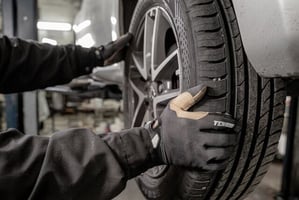When you tow a heavy trailer, keeping it steady can be a challenge. A heavy-duty spring bar system distributes weight better and controls trailer sway, giving you a smoother, safer ride.
ProPride’s design uses advanced technology that outperforms friction-based hitches. You don’t have to worry about dangerous sway or complex installations because their setup offers better towing stability without drilling into your frame.
With features like adjustable bars and one-piece yokes, this system fits your towing needs and keeps your trailer steady in tough conditions. For more details, check out the ProPride 3P® trailer sway control hitch.
Understanding Heavy-Duty Spring Bar Systems
Heavy-duty spring bar systems use strong parts and simple design to keep your trailer steady. They spread the weight evenly and control movement to help with safer towing. Knowing how they work and the different types helps you pick the right system for your setup.
Core Components and Mechanisms
A heavy-duty spring bar system uses spring bars, a hitch head, and control links. The spring bars connect the trailer frame to the hitch and flex under load to absorb road shocks. This gives stability and reduces trailer sway.
The hitch head holds everything together and lets the trailer pivot smoothly. Control links connect the bars to the hitch and manage tension and movement. Many systems have a one-piece yoke that strengthens the setup by removing weak points like strut bars.
These parts work together to offer safer and more stable towing than friction-based systems.
Load Distribution Principles
These systems spread your trailer’s weight across the tow vehicle. This prevents too much force on any single point, which can cause poor handling or damage.
Spring bars flex under pressure and move some weight to the truck’s rear axle. This balances the trailer’s tongue load and reduces sway. The placement of the bars affects how well weight is spread—adjustable offset hitch bars give you better control.
Good weight distribution helps keep all tires on the road more evenly, improving braking and steering during your trip.
Common Types and Variations
Heavy-duty spring bar setups come in different designs:
- Standard spring bar systems: Basic but strong, good for many trailers.
- Adjustable spring bar systems: Let you change bar length or offset for better weight distribution.
- Integrated anti-sway systems: Combine spring bars with technology to eliminate sway, like the ProPride 3P® Hitch.
Some models use a virtual pivot point to mimic the motion of a fifth wheel, improving towing stability. Choose based on your trailer size, weight, and how much control you want while towing.
ProPride offers advanced options that combine load distribution and sway control for a smoother, safer drive.
Key Benefits of Heavy-Duty Spring Bar Systems
Heavy-duty spring bar systems improve how your trailer handles and stays connected to your towing vehicle. They keep your load stable, make towing safer, and reduce damage to your vehicle over time.
Enhanced Load Stability
A heavy-duty spring bar system keeps your trailer stable during travel. The springs absorb and distribute forces evenly, which means less sway and bounce, even on rough roads or in windy conditions.
With a more balanced load, you have better control over your trailer. This reduces the risk of fishtailing or sudden shifts. For campers or RV owners, this stability helps keep your gear safe and gives you confidence behind the wheel.
Strong, durable materials in these bars mean they hold up under heavy weight. You avoid problems like bending or breaking, which can happen with lighter spring bars. Systems like the ProPride 3P® use patented technology to make this stability effective every time you hit the road.
Increased Safety for Towing
A heavy-duty spring bar system improves safety when pulling a trailer. By controlling sway better than standard friction hitches, it prevents dangerous trailer movements that can lead to accidents.
These systems create a “fifth wheel-like” control, improving how your trailer responds to turns and braking. This control lowers your risk of rollovers or jackknifing, especially during sudden stops or sharp maneuvers.
You also avoid unnecessary strain on your vehicle’s hitch and frame, reducing wear and preventing failure points that could cause a breakdown. A reliable system like ProPride 3P® brings peace of mind with patented features like Pivot Point Projection™ that enhance safety without complicating setup.
Reduced Wear and Tear on Vehicles
Heavy-duty spring bar systems protect your towing vehicle from excessive damage. By spreading the weight more evenly, they reduce stress on your hitch and frame. That means less risk of cracks or bent components.
Controlled movement helps your suspension and tires last longer. Without proper support, uneven or sudden shifts cause parts to wear quickly. With a heavy-duty system, forces are absorbed smoothly, extending the life of vehicle parts.
Installation is often easier and cleaner, with no need for drilling or complicated mounts. This reduces the chance of installation mistakes that could weaken your vehicle. Investing in a quality system like ProPride 3P® reduces maintenance costs and keeps your rig in better shape for longer trips.
Installation and Maintenance Best Practices
Setting up your heavy-duty spring bar system correctly and keeping it in good shape ensures stable towing and long-lasting performance. Follow clear steps for installation, check parts for wear, and address common problems quickly to avoid safety risks.
Proper Setup Procedures
Make sure your towing vehicle and trailer are on a level surface. Attach the frame brackets securely to the trailer’s frame using the bolts provided. Tighten them to the torque specified in the instructions.
Install the spring bars into the hitch box and connect the control links. Use the adjustable offset hitch bar to position the system for optimal sway control. This adjustment matches the pivot point to your trailer’s balance for smoother towing.
Use the ProPride 3P® installation guide to ensure all components fit correctly without drilling or modifying your trailer. Check the one-piece yoke alignment; it should sit straight to avoid uneven stress.
Routine Inspection Tips
Inspect your spring bars and control links before every trip. Look for cracks, rust, or bending. Pay attention to welds on the frame bracket and hitch box, as these areas bear the most force.
Check the tightness of bolts and nuts monthly, especially after long trips. Loose hardware can reduce sway control and increase wear. Lubricate the pivot points lightly with a silicone spray to keep motion smooth.
Monitor the yoke for signs of fatigue, such as hairline cracks or noise during movement. Replace any part showing damage right away to maintain towing safety and performance.
Troubleshooting Common Issues
If you notice excessive trailer sway, check if the spring bars are adjusted correctly for your trailer weight. Too loose or too tight can cause instability. Adjust the offset hitch bar to fine-tune sway control.
Unusual noises may mean worn control links or a misaligned yoke. Inspect each link for play or damage. Tighten or replace parts to restore quiet, stable operation.
If the hitch feels stiff or hard to move, check for dirt or corrosion in pivot points. Clean and lubricate them thoroughly. If problems continue, contact ProPride support for advice on the 3P® system.
Frequently Asked Questions
You need a spring bar system that’s strong, easy to replace, and fits your watch perfectly. Knowing where to buy quality parts and which tools work best can save time and prevent damage to your timepiece.
What features define the best heavy-duty spring bar system for watches?
Look for spring bars made of stainless steel or titanium for strength and corrosion resistance. The ends should fit tightly in the watch lugs to avoid slipping. Heavy-duty bars often have thicker rods and reinforced tips for extra durability.
How can I replace a watch spring bar without a spring bar tool?
You can use small flathead screwdrivers or a thin pin to release the spring bar. Work slowly to avoid scratching your watch. Be careful because spring bars are under tension and can snap out quickly.
What are the strength capabilities of heavy-duty watch spring bars?
Heavy-duty spring bars can hold more tension than standard ones, often supporting loads above 5 kg (11 lbs). This makes them suitable for larger, heavier watches and active use. Their thicker design reduces the chance of bending or breaking.
Where can I find a reliable supplier for watch spring bar replacements?
You can buy replacements online from specialty shops or trusted watch repair sites. Make sure they offer bars that fit your watch brand and model. ProPride offers durable options designed for strong, long-lasting performance.
Which is the preferred Bergeon spring bar tool for heavy-duty applications?
The Bergeon 6767-F is popular for heavy-duty use. It has sturdy tips and a comfortable grip, making precise work easier. Choose a tool that won’t bend under pressure and can handle thicker spring bars.
Are there any alternatives to traditional spring bars for securing watch straps?
Yes, you can use screw bars or quick-release pins. Screw bars use small screws for extra security, but you need proper tools to install them. Quick-release pins let you change straps quickly without tools, but they may not be strong enough for heavy-duty use.


